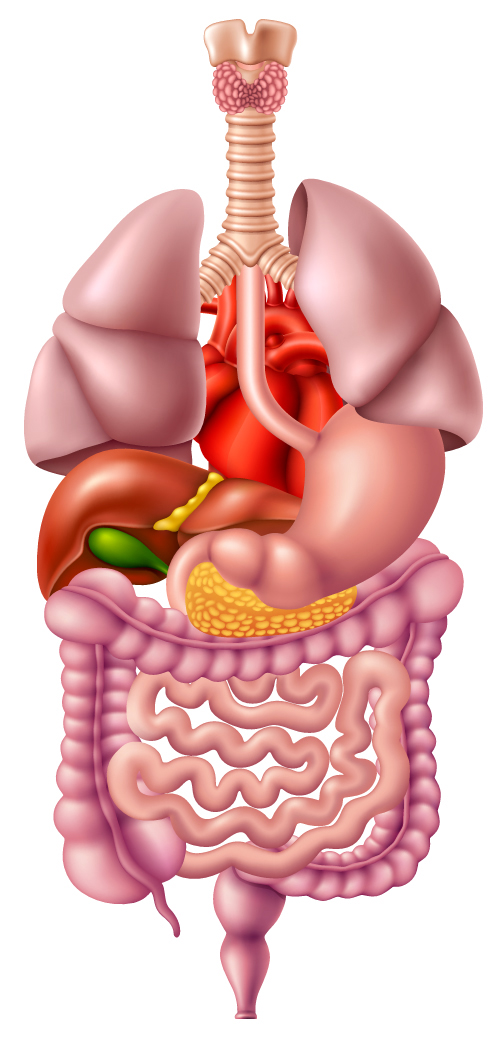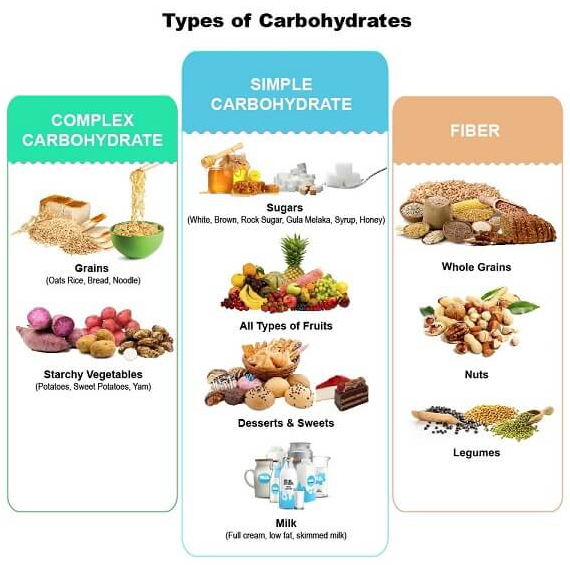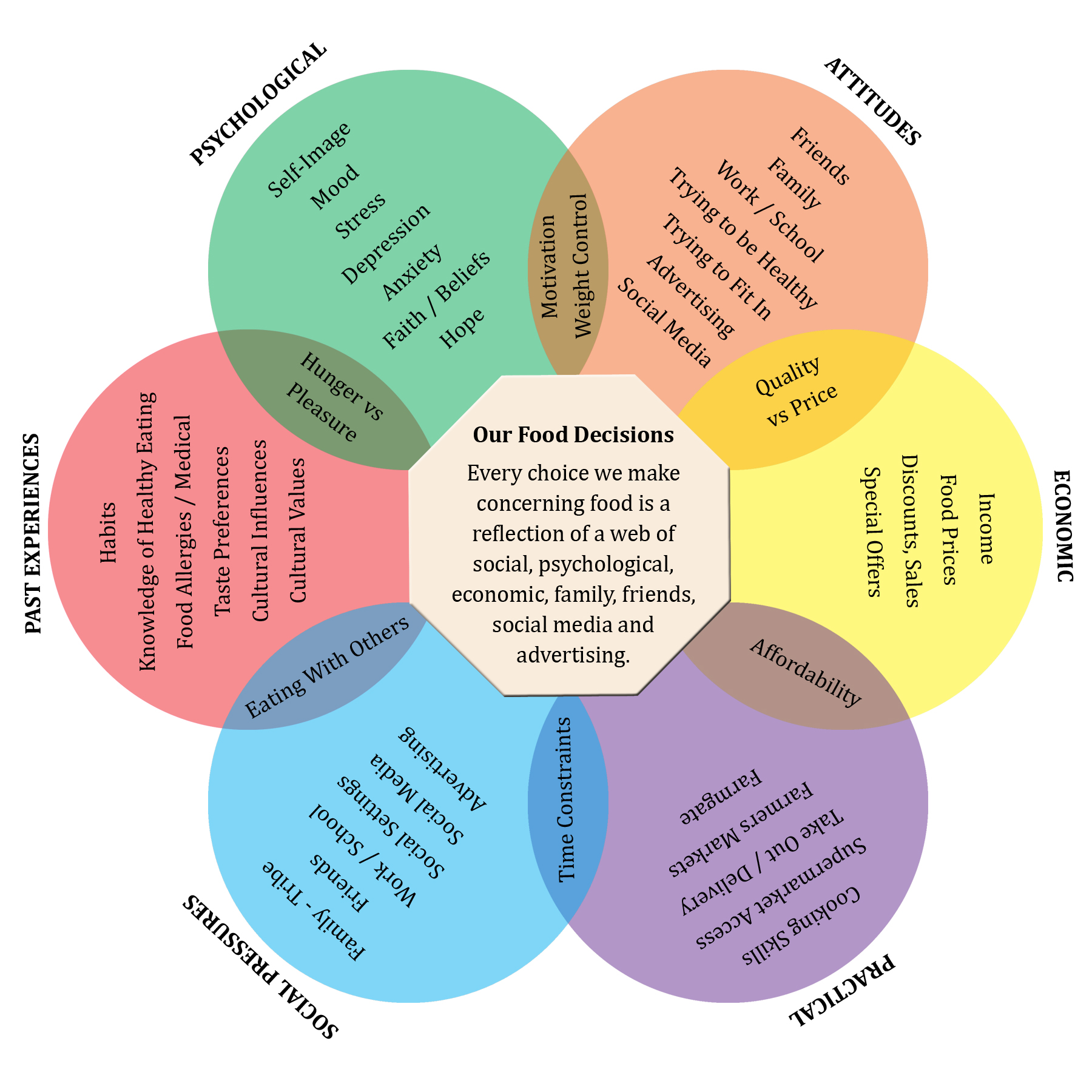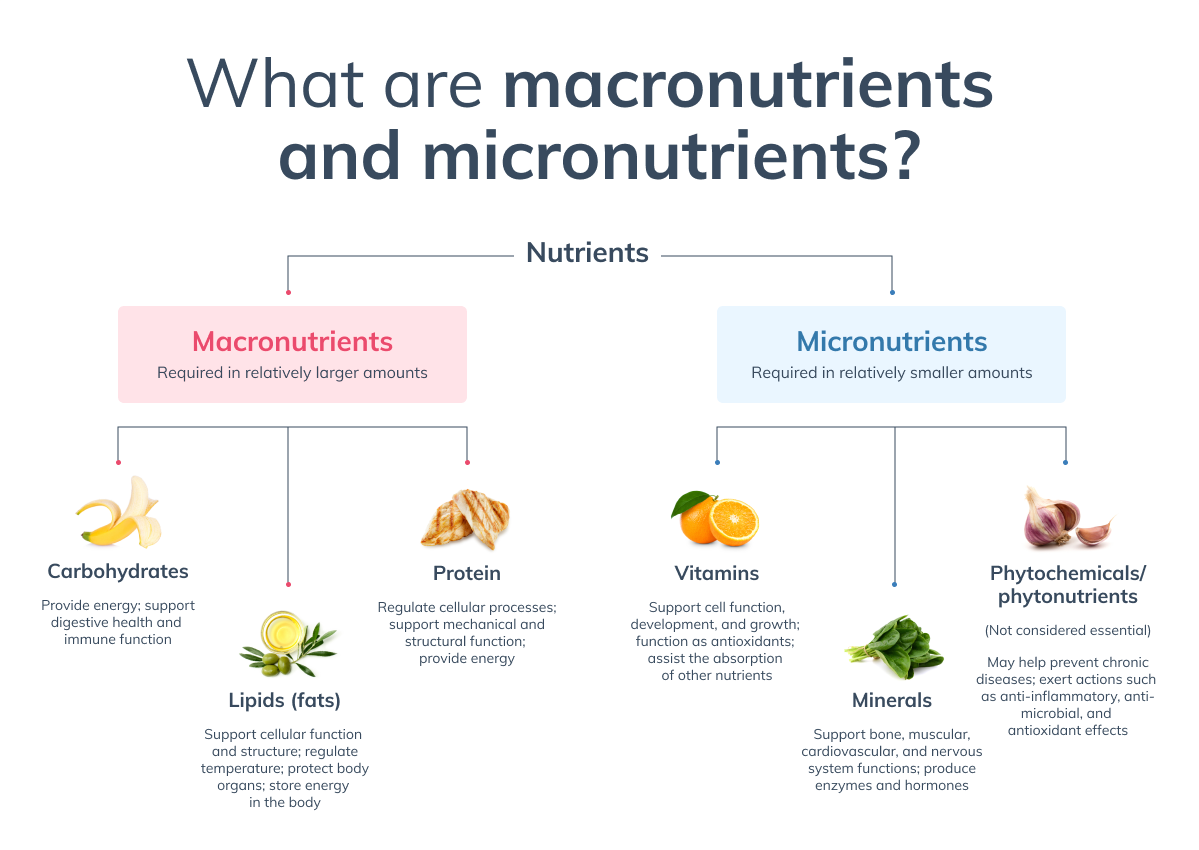
Food and Nutrition 
TABLE OF CONTENTS
- What is nutrition?
- What does eating nutritiously mean?
- How are nutrients absorbed by the body?
- What are macronutrients?
- What are micronutrients?
- What are carbohydrates?
- What are proteins?
- What are fats?
- What are vitamins and supplements?
- What are essential vitamins and their functions?
- What foods contain essential vitamins?
- What is the importance of hydration to nutrition?
- How much should you drink?
- Why changing eating habits is so difficult?
- What are the popular diet choices?
- How do you change your eating habits?
- Conclusion
Nutrition is the biochemical and physiological process by which an organism uses food to support its life. It provides organisms with nutrients, which can be metabolized to create energy and chemical structures. Failure to obtain the required amount of nutrients causes malnutrition. Nutritional science is the study of nutrition, though it typically emphasizes human nutrition. Wikipedia
What does eating nutritiously mean?
Eating nutritiously allows people to enjoy the sense of well-being that comes with good health. Adequate nutrition is vital to having a healthy body. A well maintained body is the best prospect to fighting disease and living optimally.
Getting adequate nutrients from a balanced diet is important to support general health and to prevent the risk of diseases that have been associated with a poor diet. Imbalanced or inadequate intake of certain macronutrients or micronutrients may increase your risk of certain health conditions, such as heart disease, cancer, and osteoporosis. Micronutrients and macronutrients serve different purposes in the body.
How are nutrients absorbed by the body?
 Nutrient absorption is a crucial process that allows your body to take in and utilize the essential nutrients in the foods you consume. This is the process by which nutrients are taken up from the digestive system and transported into the bloodstream to be distributed throughout the body. This process is vital for maintaining optimal health and ensuring that your body will receive the necessary nutrients to function properly.
Nutrient absorption is a crucial process that allows your body to take in and utilize the essential nutrients in the foods you consume. This is the process by which nutrients are taken up from the digestive system and transported into the bloodstream to be distributed throughout the body. This process is vital for maintaining optimal health and ensuring that your body will receive the necessary nutrients to function properly.
The process of nutrient absorption begins in the small intestine, which is lined with specialized cells known as enterocytes. These enterocytes have tiny finger-like projections called microvilli, which increase the surface area available for nutrient absorption. As food passes through the small intestine, nutrients such as carbohydrates, proteins, fats, vitamins, and minerals are broken down into smaller molecules that can be easily absorbed by the enterocytes.
Once the nutrients are broken down, they are transported across the cells of the small intestine through a process called active transport. This involves the use of carrier proteins that bind to specific nutrients and facilitate their movement across the cell membrane. From there, the nutrients enter the bloodstream and are transported to various tissues and organs where they are needed. The speed and efficiency of this process can vary depending on several factors, including the type of nutrients, the health of the digestive system, and individual factors such as age and overall health.
Macronutrients are the nutrients we need in larger quantities that provide us with energy: in other words, fat, protein and carbohydrates. There are three types of macronutrients: carbohydrates, proteins, and fats. Along with energy, all of these macronutrients have specific roles in your body that allows you to function properly. Of your daily caloric intake, 45–65% should come from carbohydrates, 20–35% from fat, and 10–35% from protein.
Micronutrients are vitamins, minerals and phytonutrients, all equally important but consumed in very small amounts. Micronutrients are essential dietary elements required by organisms in varying quantities to regulate physiological functions of cells and organs.
There are 7 essential plant nutrient elements defined as micronutrients [boron (B), zinc (Zn), manganese (Mn), iron (Fe), copper (Cu), molybdenum (Mo), chlorine (Cl)]. They constitute in total less than 1% of the dry weight of most plants. Iron, vitamin A and zinc deficiencies are amongst the most prevalent micronutrient deficiencies globally, affecting all population groups, but particularly young children and women of reproductive age.
There is no one-size-fits all when it comes to diet and nutrition. Whatever your macronutrient or micronutrient intake may be, depends on many factors. Your age, gender, genetics, metabolism, level of physical activity, social activity, influences by family/friends/community all play a part in your nutritional decisions. Learning to listen to your body and notice how you feel in response to your diet is the key to choosing and making healthy food choices.
Carbohydrates are sugar molecules. Along with proteins and fats, carbohydrates are one of three main nutrients found in foods and drinks. Your body breaks down carbohydrates into glucose. Glucose, or blood sugar, is the main source of energy for your body's cells, tissues, and organs. Glucose can be used immediately or stored in the liver and muscles for later use. Carbohydrates play a valuable role in gut health by providing useful fibre to the digestive tract.
 There are three main types of carbohydrates:
There are three main types of carbohydrates:
- Simple carbohydrates (sugars) are the most basic form. They can be added to foods, such as the sugar in candy, desserts, processed foods, and regular soda. They also include the kinds of sugar that are found naturally in fruits, vegetables, and milk.
- Complex carbohydrates (starches) are made up of lots of simple sugars strung together. Your body needs to break starches down into sugars to use them for energy. Starches include bread, cereal, and pasta. They also include certain vegetables, like potatoes, peas, and corn.
- Fiber is also a complex carbohydrate. Your body cannot break down most fibers, so eating foods with fiber can help you feel full and make you less likely to overeat. Diets high in fiber have other health benefits. They may help prevent stomach or intestinal problems, such as constipation. They may also help lower cholesterol and blood sugar. Fiber is found in many foods that come from plants, including fruits, vegetables, nuts, seeds, beans, and whole grains.
Which foods have carbohydrates?
- Grains, such as bread, noodles, pasta, crackers, cereals, and rice
- Fruits, such as apples, bananas, berries, mangoes, melons, and oranges
- Dairy products, such as milk and yogurt
- Legumes, including dried beans, lentils, and peas
- Snack foods and sweets, such as cakes, cookies, candy, and other desserts
- Juices, regular sodas, fruit drinks, sports drinks, and energy drinks that contain sugar
- Starchy vegetables, such as potatoes, corn, and peas
- Some foods don't have a lot of carbohydrates, such as meat, fish, poultry, some types of cheese, nuts, and oils.
- Healthy carb choices – click here

The protein macronutrient is a major player in the diet, considered to be the body’s building block, used to form and repair muscles, skin, hair, nails, cartilage, and bones. Protein enables most of the body’s vital metabolic functions to work intrinsically with the whole body.
Proteins are made up of amino acids. Short chains are called peptides and longer chains are called polypeptides. Protein chains can be complex.
Because the body cannot store proteins in the same way it does other macronutrients, a person needs to consume proteins on a daily basis.
Your body needs protein for all sorts of important work. Most adults should get 10% to 35% of their daily calories from protein. For men, that works out to around 56 grams of protein a day, and for women, it’s about 46 grams per day.
The primary role of proteins is forming and maintaining the structural foundation of the body: muscles, bones, skin, hair and nails, and internal organs. Every cell in the body contains protein—it is essential for the structure and function of every part of the body. Amino acids that make protein are the raw materials for building and repairing body tissues.
Our bodies continuously break down proteins. The ongoing process of replacing old proteins with new ones is essential for repairing and regenerating body tissues. There are times when the body’s protein needs increase—such as when recovering from an illness, surgery, or injury. Older adults and pregnant or breastfeeding women will require more protein to maintain optimal health.
Proteins create enzymes, which are important for every biochemical reaction and function in the body. Enzymes are complex proteins that act as catalysts for chemical reactions in the body related to energy production, growth, nutrient digestion, muscle function, and blood clotting, as well as playing an role in the body’s detoxification process.
Hormones act as chemical messengers that travel in the bloodstream, regulating many body processes. Hormones, called peptide hormones, are made up of proteins. Peptide hormones are critical in regulating growth, mood, and metabolism. Examples of protein-based hormones include: Insulin, Epinephrine (adrenaline), Oxytocin, Thyroxine, and growth hormones.
Protein is vital for optimal immune. Cytokines are small proteins that control the growth and activity of other immune cells. When cytokines are released into the bloodstream, they send signals that regulate the action and function of other immune cells to protect the body from any potential threat. Cytokines play an important role in the body’s inflammatory response.
Antibodies are proteins circulating through the bloodstream that identify and neutralize foreign substances, such as bacteria and viruses.
Getting enough protein in your diet is an excellent way to support your overall health.

Fat is a macronutrient along with carbohydrates and proteins found in food. It is vital for the body’s function, including processes such as brain activity, hormone production and the body’s absorption of other nutrients from the diet. Fats are also referred to as “triglycerides” which are comprised of glycerol and three different fatty acids.
Fats are a major source of energy for our bodies. It helps us to absorb vitamins and minerals. We need fat to build cell membranes, the vital exterior of each cell, and the sheaths surrounding nerves. Fat is essential for blood clotting, muscle movement, and inflammation. Some fats are better than others. Good fats include monounsaturated and polyunsaturated fats. Bad fats include industrial-made trans fats. Saturated fats fall somewhere in the middle.
Fats all have similar chemical structures: a chain of carbon atoms bonded to hydrogen atoms. What makes one fat different from another is the length and shape of the carbon chain and the number of hydrogen atoms connected to the carbon atoms; thus there are major differences in their form and function.
Omega-3 and Omega-6 are considered essential fats because our bodies cannot manufacture these on their own. We need to consume Omega-3 foods such as oily fish, and Omega-6 rich foods such as meat and nuts.
There are four main classifications of fat that we can find in our food:
So we have all heard about “good fats” and “bad fats” but what exactly are they? Check out HealthLine on this topic. So much great information to share on this topic. No point in recreating the data.

What are vitamins and supplements?
Vitamins are found naturally in the foods you eat. The human body uses them to function. They play an important role in supporting a positive health outlook. Typically, a diet that’s balanced and nutrient-filled is enough to get all the vitamins your body needs.
Supplements can help people get essential vitamins if they’re unable to obtain them through their diet. Getting the daily recommended amount of each vitamin can help keep you healthy.
What are essential vitamins and their functions?
A: Promotes cell development, and healthy skin, hair, nails, gums, glands….
C: Strengthens blood vessel walls; promotes wound healing and iron absorption; supports the immune system.
D: Aids calcium absorption, and builds and maintains strong bones and teeth.
E: Protects fatty acids; maintains muscles and red blood cells; and serves as an important antioxidant.
K: Used by the body for proper blood clotting.
B1 – thiamine: Maintains a healthy metabolism. It also helps maintain normal digestion, appetite and proper nerve function.
B2 – riboflavin: Essential for energy metabolism. It also aids adrenal function, supports normal vision and helps maintain healthy skin.
B3 – niacin: Is used to metabolize energy and promote normal growth. In large doses, Vitamin B3 can also lower cholesterol.
B5 – pantothenic acid: Aids energy metabolism and normalizes blood sugar levels.
B6 – pyroxidine: Promotes protein metabolism, metabolism of carbohydrates and the release of energy. It also plays a role in proper nerve function and the synthesis of red blood cells.
B7 – biotin: Maintains a healthy metabolism.
B9 – folate: Important in making DNA, RNA, red blood cells, and synthesize certain amino acids. Vitamin B9 is also important for pregnant women, as it helps prevent birth defects.
B12 – cobalamin: Used to make red blood cells, DNA, RNA, and myelin for nerve fibers.

What foods contain essential vitamins?
A: Beef, shrimp, fish, sweet potato, squash, spinach.
C: Bell peppers, brussel sprouts, potatoes, citrus fruits such as oranges and grapefruits.
D: Fatty fish like salmon, mackerel, and tuna, cheese, egg yolk, mushrooms.
E: Leafy green vegetables, whole grains, nuts, vegetable oils.
K: Cabbage, liver, collards, sprouts, kale, eggs, milk.
B1 – thiamine: Pork, fish, legumes, soymilk, watermelons, ham.
B2 – riboflavin: Milk, eggs, yoghurt, cheese, meats, green leafy veggies, fortified cereals, whole grains like brown rice.
B3 – niacin: Meats–beef, pork, poultry, fish, mushrooms, potatoes, peanut butter.
B5 – pantothenic acid: Egg yolks, avocado, asparagus, broccoli, tomatoes.
B6 – pyroxidine: Tofu, soy products, poultry, fish, beef, pork.
B7 – biotin: Organ meats (e.g. liver), whole grains, fish, egg yolks.
B9 – folate: Asparagus, okra, spinach, turnip, broccoli, orange juice, tomato juice, legumes like chickpeas.
B12 – cobalamin: Fortified cereals, beef, pork, fortified soymilk, cheese, poultry, fish, milk.

What is the importance of hydration to nutrition?
While the average percentage of water in a person’s body is around 60%, the percentage can vary from roughly 45–75%. Water makes up the majority of your body weight and is involved in many important functions. This includes flushing out waste from your body, regulating your body temperature, and helping your brain function. Most water comes from drinkable sources, but food also contributes small amounts to the daily water intake. We hear it all the time—water is essential for the health of the body—but why?
- It helps create saliva
- Water is the main component in saliva. Saliva includes small amounts of electrolytes, mucus, and enzymes that are essential for breaking down solid food and keeping your mouth healthy.
- The body produces enough saliva with regular fluid intake.
- Saliva production may decrease as a result of age or certain medications or therapies.
- It regulates the body temperature
- Staying hydrated is crucial to maintaining ideal body temperature.
- The body loses water through sweat during physical activity and in hot environments.
- Sweat keeps the body cool, but body temperature will rise if you don’t replenish the water you lose. That is because the body loses electrolytes and plasma when it’s dehydrated.
- It protects your tissues, spinal cord, and joints
- Water consumption helps lubricate and cushion the joints, spinal cord, and tissues. This will lessen the discomfort caused by conditions like arthritis.
- It helps excrete waste through perspiration, urination, and defecation
- Your body uses water to sweat, urinate, and have bowel movements.
- You need enough water in your system to have a healthy stool and to avoid constipation.
- The kidneys are important for filtering out waste through urination. Adequate water helps your kidneys work more efficiently and helps to prevent kidney stones.
- It helps maximize physical performance
- Drinking plenty of water during physical activity is essential. Athletes may perspire up to 6 to 10% of their body weight during physical activity.
- Hydration also affects strength, power, and endurance.
- Negative effects of exercise in the heat without enough water can include serious medical conditions, like decreased blood pressure and hyperthermia. Extreme dehydration can cause seizures and even death.
- It helps prevent constipation
- It is important to maintain adequate water intake so that bowel movements contain enough water.
- Consuming enough water, magnesium and fibre will likely reduce symptoms of constipation.
- It aids in digestion
- Studies show drinking water before, during, and after a meal will help your body break down the food you eat more effectively.
- It helps with nutrient absorption
- In addition to helping with food breakdown, water also helps dissolve vitamins, minerals, and other nutrients from your food and delivers these components to the rest of the body for use.
- It helps you lose weight
- Drinking more water while dieting and exercising may help with weight loss.
- It improves blood oxygen circulation
- Water carries helpful nutrients and oxygen to the entire body.
- Drinking the daily recommended intake of water will improve circulation and have a positive impact on overall health.
- It helps fight off illness
- Drinking enough water can help prevent certain medical conditions, such as:
- constipation
- kidney stones
- exercise-induced asthma
- urinary tract infections
- hypertension
- Water helps with the absorption of important vitamins, minerals, and nutrients from food.
- Drinking enough water can help prevent certain medical conditions, such as:
- It helps boost energy
- Drinking water may activate your metabolism which has been associated with a positive impact on energy level.
- It aids in cognitive function
- Proper hydration aids in healthy cognitive function. Studies indicate that failure to drink enough water can negatively impact focus, alertness, and short-term memory.
- It helps improve mood
- Dehydration may result in fatigue and confusion as well as anxiety and mood.
- It helps keep skin bright and tight
- Adequate water intake helps skin hydrate and may promote collagen production.
- It prevents overall dehydration
- Dehydration is the result of your body not having enough water which is imperative to so many bodily functions.
- Dehydration is very dangerous.
- Severe dehydration can result in:
- swelling of the brain
- kidney failure
- seizures
- Make sure to drink enough water to make up for what’s lost through sweat, urination, and bowel movements to avoid dehydration.
- Most people drink when they’re thirsty, which helps regulate daily water intake. Be attentive to your body’s needs.
- According to research—water including beverages should be:
- about 15.5 cups of water (125 ounces) each day for men
- about 11.5 cups (91 ounces) daily for women
- People get about 20% of their daily water intake from food. The rest is dependent on drinking water and water-based beverages. So, ideally men would consume about 100 ounces (3.0 liters) of water from beverages, and women, about 73 ounces (2.12 liters) from beverages.
- Increase your water intake if you’re exercising or living in a hotter region to avoid dehydration.
Other ways to assess hydration include your monitoring your thirst and the color of your urine. Feeling thirsty indicates your body is not receiving adequate hydration. Urine that is a dark colour indicates dehydration. Pale or non-coloured urine typically indicates proper hydration.
Why do so many people have poor diets and eating habits?
People develop poor eating habits over time based on a number of factors that assist in making food choices. Many social and economic factors interact in a complex manner to shape individual dietary patterns, such as food preferences, income, food prices, beliefs, cultural traditions, geographical and environmental aspects. The psychology behind how, why and what we eat is very complex and involves many, many factors. The following chart breaks down just how we make those decisions.

Studies show:
- Highly palatable foods are more likely to be consumed–hedonic eating.
- Lower income families spend more on food compared to higher income families.
- Lower income families consume more fast foods, sugar, salty foods, deserts, biggie-meals and quick meals.
- Millions are spent by corporations and restaurants to attract consumers to purchase fast, tasty meals backed by advertising and social media.
- Limited access to supermarkets, farmers markets and farmgate that sell healthy foods make it difficult for families to make healthy food choices.
- Many food subsidized programs, food kitchens and shelters do not supply healthy food choices.
- Many hospitals, retirement homes and institutions have food standards that are below what would be considered a healthy, nutritional meals.
- Eating with friends and families in social settings tends to increase food intake.

Why is changing eating habits so difficult?
Diets are terrible. Almost everyone tries one, and almost everyone fails at it. Perhaps because diets are hard to stick to. After a few months or a few weeks, people fall back into old habits.
The average person could probably recite the recipe for healthy eating–more fruits and vegetables, less red meat and processed foods. It sounds simple enough. Yet most people struggle to follow a healthy diet.
Part of the problem lies in people’s misguided assumptions. Many still view healthy eating as being too restrictive— low fat, low calorie, low sugar, no meat, low carb. Then there are the perceptions that healthy foods are expensive and recipes are too complex. Overall, the message that the brain is receiving is that “healthy eating takes too much work and is not tasty.”
Diets are meant to tame erratic eating behaviours and revise poor food choices. Such strategies hardly ever work because they are too extreme and almost impossible to maintain over a long term period of time.
What are the popular diet choices?
- Low-carb, whole-food diet. The low-carb, whole-food diet is perfect for people who need to lose weight, optimize health, and lower their risk of disease. ...
- Mediterranean diet. ...
- Paleo diet. ...
- Ketogenic diet. …
- Vegetarian diet. …
- Vegan diet. ...
- Gluten-free diet. …
- Intermittent diet. …
- Atkins diet. …
How do you change your eating habits?
Start with your brain: If you want to improve your body, you must also improve your mind-set. Decades of research show that individuals who want to live a healthier life must become conscious of their food choices. Making simple, gradual changes to your eating patterns is the best way to promote better nutrition.
Before making changes to your diet and your supplements, you need to understand your current eating patterns, which may require considerable thought, research and attention.
As you begin to make small tweaks to your daily eating habits, start to plan a few meals you like that you can cycle through on a regular basis, so you don't have to think too hard about what you're going to eat every day. Little by little you will start to take charge of your nutritional intake, your health and your wellbeing.
Taking charge of your health through nutrition by eating healthy foods, managing shopping lists and meal planning is not an easy task. It takes a total change in one’s habits and lifestyles. This is not an easy task. The best way to tackle these changes is by changing how one thinks (The Mind), knowing one’s body–what your body craves, needs and thrives on as well as what your body is physically capable of handling (The Body). Then there is how you feel about yourself (Spirit and Soul), how you treat yourself–do you love yourself? All these things play a very important part in one’s daily lives and in one’s ability to heal from any chronic illness or disability.
Source: VeryWellHealth
Source: HealthLine
Source: Eatingwell
Source: PubMed
Source: Wikipedia
Resources: Books—Nutrition
![]()
"The doctor of the future will no longer treat the human frame with drugs but rather will cure and prevent disease with nutrition." — Thomas Edison.
